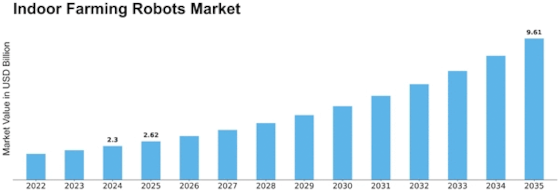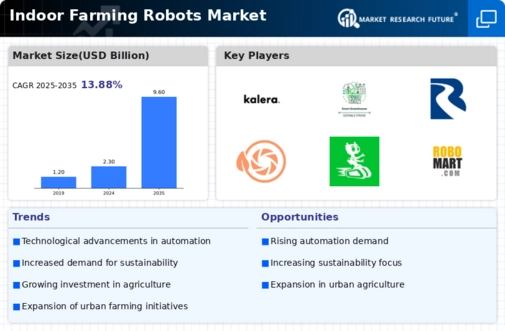Indoor Farming Robots Size
Indoor Farming Robots Market Growth Projections and Opportunities
The market for indoor farming robots is influenced by several key factors that shape its growth and development. Firstly, technological advancements play a significant role in driving the market forward. As robotics and automation technologies continue to evolve, indoor farming robots become more efficient, precise, and cost-effective, attracting both investors and consumers. These advancements include improvements in sensor technology, artificial intelligence, and machine learning algorithms, which enable robots to accurately monitor plant health, optimize resource usage, and adapt to changing environmental conditions.
Secondly, the increasing demand for sustainable food production methods drives the adoption of indoor farming robots. With growing concerns over food security, climate change, and land scarcity, there is a heightened interest in alternative farming techniques that minimize environmental impact and maximize resource efficiency. Indoor farming, facilitated by robotics, offers a solution by enabling year-round cultivation in controlled environments, reducing the reliance on traditional agriculture methods that are often vulnerable to climate fluctuations and resource depletion.
Moreover, shifting consumer preferences towards organic, locally sourced produce further propel the indoor farming robots market. Consumers are becoming more conscious about the origin and quality of their food, preferring fresh, pesticide-free products that are grown closer to home. Indoor farming robots enable farmers to meet this demand by producing high-quality crops in urban or suburban areas, minimizing transportation costs and carbon emissions associated with traditional farming practices.
Additionally, government initiatives and incentives play a crucial role in fostering the growth of the indoor farming robots market. Many governments around the world are implementing policies to support sustainable agriculture and promote innovation in the farming sector. These policies may include grants, subsidies, or tax incentives for farmers adopting indoor farming technologies, thereby reducing the barrier to entry and encouraging widespread adoption of robotic farming solutions.
Furthermore, the scalability and flexibility of indoor farming robots make them attractive to a diverse range of stakeholders, including commercial growers, urban farmers, and hobbyists. Whether it's a large-scale vertical farm or a small hydroponic setup in someone's backyard, indoor farming robots can be tailored to fit various needs and budgets. This versatility expands the market potential and fosters innovation as companies compete to develop solutions that cater to different segments of the market.
However, challenges such as high initial investment costs, technological complexities, and regulatory hurdles may hinder the widespread adoption of indoor farming robots. Despite the long-term benefits in terms of sustainability and efficiency, some farmers may be hesitant to invest in new technologies due to uncertainty or lack of understanding. Additionally, regulatory frameworks governing indoor farming practices and the use of robotics may vary across regions, posing compliance challenges for industry players.

















Leave a Comment